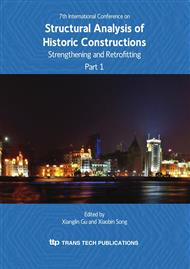p.959
p.965
p.971
p.977
p.985
p.991
p.997
p.1003
p.1009
On 4R Principle in the Rehabilitation of Concrete Historic Buildings
Abstract:
vThe 4R principle refers to reduce, reuse, recycle and regeneration, which should be implemented in the process of concrete treatment. In terms of the special micro-structural properties and self-repairing capacity, concrete is one kind of regenerative construction materials. Through proper handlings, self-repairing (crack close-up) of concrete cracks is possible in the concrete hydration damaged region. Due to the effect of heterogeneous nucleation and subsequent crystal growth of calcium hydroxide, a better bonding strength forms interlocking the new and old concrete interfaces. A proposal on the relationship between the self-repairing, regeneration function of concrete and the rehabilitation of historic buildings is suggested, this is based on the formed process of the bonding strength of the interfaces and the function on concrete repairing. Besides the constitution and features of the microstructure of concrete, the relationship between the micro-structure and the macro-mechanical property is also investigated in this paper
Info:
Periodical:
Pages:
985-990
Citation:
Online since:
October 2010
Authors:
Keywords:
Price:
Сopyright:
© 2010 Trans Tech Publications Ltd. All Rights Reserved
Share:
Citation:


